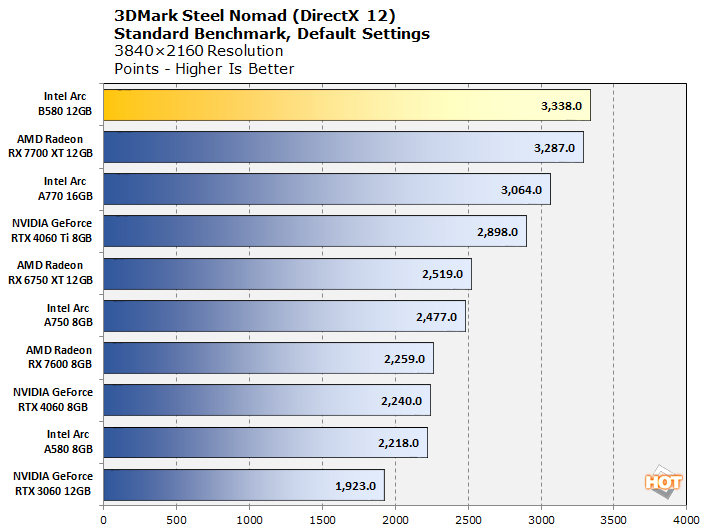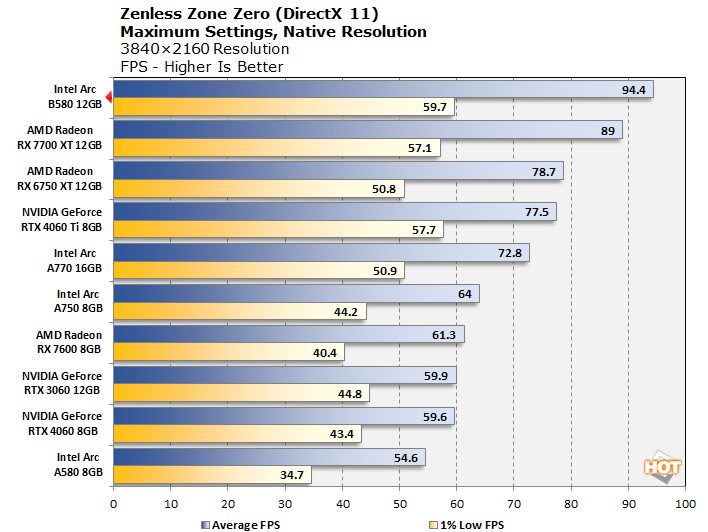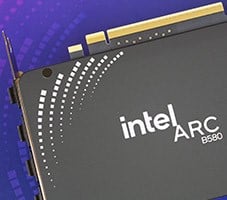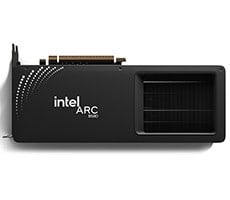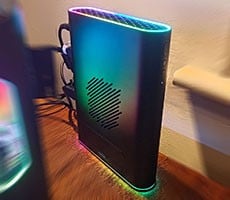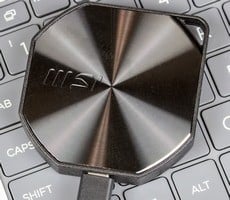Of course, there's a fair bet that you're not here to look at AI inference benchmarks. You want to know how well this $250 graphics card plays PC games. We've got no less than twenty game tests all lined up for you, but we're going to start off the gaming benchmarks with an old standby: 3DMark.
UL 3DMark Synthetic Gaming Benchmarks
3DMark has been around longer than some people in our audience have been alive. From the original 3DMark release in 1999 to the latest benchmarks now, the change in visual quality is nothing short of astonishing. First, we're going to take a look at the latest benchmark added to 3DMark,
known as Steel Nomad.
Steel Nomad is interesting because it doesn't make use of ray-tracing or any other particularly fancy rendering features. It's a full-on 4K raster benchmark that pushes unbelievable numbers of polygons and really hammers the fill rate and memory bandwidth of any particular GPU. The Arc B580 takes away a surprise win here, though only just so. Impressive stuff from Intel.
Meanwhile, the 3DMark Speed Way benchmark makes heavy use of DXR, or
DirectX Ray Tracing. It boasts astonishingly life-like lighting in the futuristic, sci-fi setting. It's a shame we don't really get to see the nominative Speed Way, but the view inside the racer's garage is still quite a thing to behold. The Arc B580 drops a few slots here, but still manages to beat all of its previous-gen predecessors. Check out the Radeon RX 7700 XT basically tying the
GeForce RTX 4060 Ti as well.

We saved the oldest benchmark for last: 3DMark Time Spy. This isn't the oldest benchmark available in the current version of the app; that honor would go to Fire Strike, which Steel Nomad has largely replaced. It is the oldest one we elected to test, though. We wanted to present these results this way because they reveal something very interesting, and that is that our Core Ultra 9 CPU scores come out radically different depending on what brand of GPU we're testing with. The improved CPU scores of the NVIDIA cards, no doubt thanks to the green team's tightly-optimized driver, allow them to punch higher in the rankings than they otherwise might.
The Arc B580 manages to defeat all comers in Time Spy save for the powerful Radeon RX 7700 XT—and it's not far behind. This is very promising for the fledgling GPU, but we do have to note that Arc has always punched above its weight class in 3DMark. How about some real games?
Final Fantasy XIV Dawntrail Benchmarks
First up we have a certified weeaboo classic: Final Fantasy XIV. We are of course using the latest version of the game's stand-alone benchmark, which adds long-overdue physical-based rendering to the game's rendering pipeline, drastically improving the appearance of surfaces and materials.
Final Fantasy XIV isn't doing anything particularly fancy technologically, so this basically comes down to a test of raster hardware. The Arc B580 matches the larger and hotter Radeon RX 6750 XT blow for blow while easily outpacing
the Intel Arc A770 and its weaker ancestors. Not bad.
Warframe 1999 Gaming Benchmarks
Warframe 1999 is a forthcoming major update to the mega-popular live service third-person shooter. You can't play it yet, but there is a demo available inside the Warframe game client. It makes a perfect place to test performance in Warframe because it has a fixed layout, unlike the procedurally-generated environments in most of the game. It's also really, really detailed.
Here,
Battlemage stumbles slightly, allowing the GeForce RTX 4060 Ti to take second place behind the beefy RDNA 3 card, but this is still an excellent showing for a $250 GPU. Note that this game is outputting full 4K resolution to the display, and we tested with AMD FSR for upscaling, so the GPUs are having to divert shader power to upscaling that could otherwise be spent on rendering the game.
Palworld Benchmarks
Palworld may not be as popular as it once was, but the game still pulls tens of thousands of players every single day, so we figure it's worth a look. This game makes use of
Unreal Engine 5, but doesn't take advantage of any of its advanced rendering features, partially because it's still on DirectX 11.
Testing Palworld is a little clumsy because object and Pal spawns are completely randomized every time you load the game, so there's more variation in these numbers than we'd like. Still, you can easily see that the Arc B580 is running right along behind the two much more expensive graphics cards. Cue more applause for Intel's graphics team.
Zenless Zone Zero Benchmarks
Released this year on Unity engine by Chinese developer Hoyoverse—better known for the "Honkai" and "Genshin" properties—Zenless Zone Zero is a third-person gacha action title with highly stylized visuals in a unique and striking style. The game is gorgeous despite that it's strictly PlayStation 4 in terms of technology. We tested it in full native 4K with no scaling.
Look at that? The Battlemage brings home its first win in a real game—and by a pretty fair margin, too. NVIDIA's cards have the better frametime consistency, as usual, but the B580 is holding up well in that regard. With a variable refresh rate monitor, you'd never notice the difference.
Retro FPS Selaco Benchmarks
Hotly-anticipated for a long time before it finally released early this year, Selaco is a retro-styled first-person shooter built on an advanced version of the original DOOM engine. It features high-detail sprites, particle effects, advanced movement physics, and many voxel objects. It's an awesome, fast-paced shooter that you're probably missing out on.
A last place finish for Arc B580 here, but it's not without its caveats. You'll notice that the Arc cards are marked with "OpenGL". That's because attempting to launch this game on an Arc GPU of any kind causes it to crash, as Selaco defaults to a Vulkan renderer that doesn't seem to play nice with the Intel Vulkan driver. You can run the game in OpenGL mode, but performance suffers badly as a result, especially on Battlemage. We've reported this issue to Intel already, but it's an example of the kind of compatibility problems you can still occasionally run into in PC gaming.
Doom Eternal Benchmarks
Of course, if we're talking about "Vulkan-powered FPS games," it has to be
Doom, right?
Doom Eternal is hardly a new game anymore, having released in 2020, but it's still a blast to play, especially with the unlimited ammo cheat. Id Software's engine is characteristically well-optimized, so we tested this game in 4K mode with a 67% render scale, equivalent to "Quality" mode in DLSS, FSR, or XeSS.
The Arc B580 takes home another win here, and it's an even bigger win than you might realize. Ultra Nightmare settings in this game require more than 8GB of video RAM; to even test the 8GB GPUs here, we had to lower the game's settings a notch to "Ultra" before it would even let us play. This configuration includes ray-traced reflections and they're no problem for Battlemage.
Baldur's Gate 3 RPG Benchmarks
The long-awaited sequel to the duology of classic Bioware Dungeons & Dragons RPGs was itself a mega-hit, cementing it as a modern-day classic. It's really more of a CPU benchmark than a GPU benchmark, but we went ahead and tested this game on the Arc B580 anyway using a save game early in the title's third act after arriving in the city of Baldur's Gate proper.
It's not completely clear why the older, Alchemist-based Arc A580 falls off so hard in this benchmark, but the new Arc B580 comports itself just fine. We do think Intel has some work to do on its Vulkan stack because this game suffers frame pacing issues on Battlemage, but they're not experience-ruining. You simply don't get to appreciate that silky-smooth 65.2 FPS as much as you should.
Indiana Jones and the Great Circle Benchmarks
A brand-new release from MachineGames, Indiana Jones and the Great Circle is a first-person action game with a fresh story for the whip-slinging adventurer. Harrison Ford is nowhere to be seen, but we do get the talented Troy Baker doing a reasonable facsimile of a young Ford's voice.
Even in 1080p, the "High" settings in this game are brutal, as it does not employ anything besides top-notch ray-traced lighting. Check out our poor Radeon RX 7600, which can't even maintain double-digit frame rates. Everything else performs passably, but the
Arc B580 has the most consistent frame times in the group. 8GB cards struggle here, but it is possible to make the game run smoothly on an 8GB card if you drop the settings down to the floor.
The majority of the games coming out for PCs these days employ Microsoft's DirectX 12 API, and likewise the majority of the games we tested. Head to the next page to see those benchmarks next...
